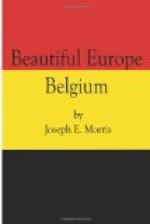III.
Of Brussels I do not propose to say very much, because Brussels, although the brightest and gayest town in Belgium, and although retaining in its Grande Place, and in the buildings that immediately surround this last, as well as in its great church of St. Gudule (which, in spite of popular usage, is not, and never was, in the proper sense a cathedral), relics of antiquity of the very highest value and interest, yet Brussels, as a whole, is so distinctively a modern, and even cosmopolitan city, and has so much general resemblance to Paris (though its site is far more picturesque, and though the place, to my mind at least, just because it is smaller and more easily comprehensible, is a much more agreeable spot to stay in), that it seems better in a sketch that is principally devoted to what is old and nationally characteristic in Belgium to give what limited space one has to a consideration rather of towns like Louvain or Malines, in which the special Belgian flavour is not wholly overwhelmed by false and extraneous influences. St. Gudule, of course, should certainly be visited, not only for the sake of the general fabric, which, notwithstanding its possession of two west towers, is typically Belgian in its general character, but also for the sake of its magnificent sixteenth and seventeenth century glass, and especially for the sake of the five great windows in the Chapelle du Saint Sacrement, which illustrate in a blaze of gorgeous colour the story of how Jonathan the Jew bribed Jeanne de Louvain to steal the three Consecrated Wafers, from which oozed, when sacrilegiously stabbed by the sceptical Jew, the Sacred Blood of a world’s redemption. This story is told again—or rather, perhaps, a similar story—in the splendid painted glass from the church of St. Eloi that is now preserved at Rouen in the Archaeological Museum. As for the Grande Place, or original market-place of the city, which is bounded on one side by the magnificent Hotel de Ville, on the opposite side by the rather heavy, rebuilt Maison du Roi, and on the remaining two sides chiefly by the splendid old seventeenth-century Corporation Houses of the various ancient city guilds—Le




